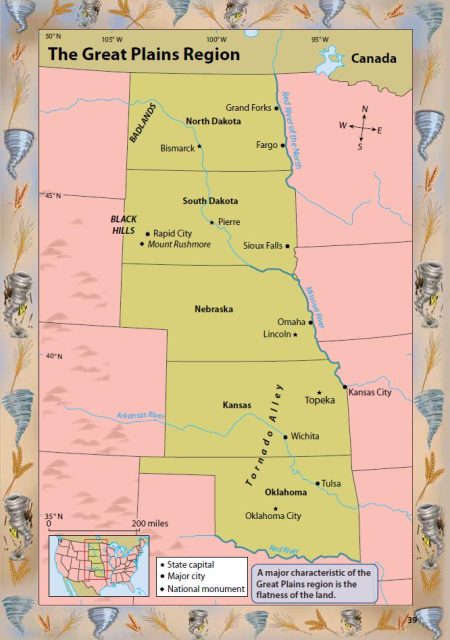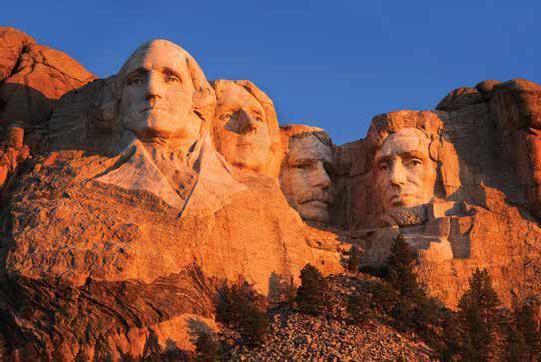The Great Plains
Exploring the Great Plains From the Midwest, we traveled west to the region known as the Great Plains. This region is located near the center of the United States. It includes the states of Oklahoma, Kansas, Nebraska, South Dakota, and North Dakota. As you know, Admiral, a plain is a flat area without hills or mountains. Flying over it, we were amazed at just how flat most of this region is. We noticed, too, that there are not as many big cities here as there are in the East or the Midwest. Instead, the land is covered with many farms and ranches.
Flying over the eastern part of the Great Plains, we saw huge fields of wheat. So much wheat is grown in this area that it is called America’s Breadbasket. Wheat is used to make the food called read. In the western part of the region, we saw cattle ranches, where much of the country’s beef is raised. Another important product of the region is oil. Oil is turned into gasoline that helps run the millions of cars that Americans drive.

Early Life on the Great Plains
When we read about the history of the Great Plains, we learned how much the region has changed in the last two hundred years. We learned that if we had flown over the plains in the early 1800s, we would have seen thousands of animals called bison. The Native Americans who lived in the region hunted the bison for food. They also made use of many parts of the bison, especially the hide.
In the 1800s, European settlers began moving into the Great Plains, taking over land that had belonged to the Native Americans. The settlers also hunted the bison, and later, in an attempt to defeat Native American resistance to increased European settlement, they killed so many bison that the great herds almost vanished. The destruction of the herds seriously harmed the Native American way of life on the Great Plains.

The Native Americans were unable to stop the advance onto their lands. When the U.S. Army came west to support the settlers, the Native Americans were eventually forced to move to special areas called reservations.
At one time, the present-day state of Oklahoma was called Indian Territory, and many Native Americans from various parts of the United States were forced to move there. Although they lost large areas of land across the United States, the Native American cultures survived. Today, Native Americans live throughout the United States. People have always had to be tough to survive on the Great Plains. The region has little water and a harsh climate, with hot summers and freezing winters.
Spring is tornado season in the Great Plains. A tornado is a type of storm that occurs when a swirling cloud shaped like a funnel passes over the land. Tornadoes bring destructive winds of more than one hundred miles per hour. Many of the tornadoes on Earth happen in a part of the Great Plains called Tornado Alley.
In the northern part of the region, the winter weather is especially harsh. This might be one reason why the states of North and South Dakota have so few people. North Dakota is bigger than the state of New York, but New York has more than twenty times as many people.
In South Dakota, we visited an area called the Badlands. There we saw colored hills of rock carved into different shapes by erosion. People called this land bad because it was dry and barren.

In a national park near the Badlands, four gigantic faces stare down from the side of a hill. The massive sculpture, called Mount Rushmore, features the faces of four American presidents: George Washington, Thomas Jefferson, Theodore Roosevelt, and Abraham Lincoln. Each face is almost sixty feet tall. As we flew on to the next region, the image of these men stayed with us for a long time.